Abstract
The objective ways to increase attention to students aged 13-14, given its forms of manifestation: focused attention, perception of attention and distributive attention through a dance program - therapy. The purpose elaboration of an action strategy for increasing the attention capacity through different dance-therapy techniques. Material and Methods: Statistical processing was performed with the program StatsDirect v.2.7.2. The graphical representation of the results was done with the Excel application (from the Microsoft Office 2010 package). The tests used are: AP2 - Perception of attention; MA – focussed attention; AD - Distributive attention. The subjects participating in the experiment with a duration of 6 months by 30 students of the National College "George Baritiu" Cluj-Napoca, between October 2016 - March 2017. Results: In the statistical analysis of the values for the perception of attention and the spirit of observation (AP2) were observed statistically significantly significant differences between the two times (p <0.001). Statistically significant differences were observed in the indicators of the AP2 tests (perception of attention) which indicates, that our intervention program in the preliminary study had a positive and measurable impact on students in terms of improving negative perceptions as well as increasing attention and observation.
Keywords: Distributive attentionfocused attentionperception of attention
Introduction
Music and dance-therapy had a substantial effect on children's sensorimotor development including balance and correct position, locomotion, agility, strength and laterality (Barksdale, 2006). Music motivates and can be a good element for distraction of the attention.
A 16-week educational program, combined with dance therapy, appears to have a positive effect on the quality of life of obese people (Allet et al., 2017). Dance is more than a therapy, it can offer more than therapeutic benefits, the researchers reaching this conclusion by analyzing Parkinson's disease and applying therapeutic dance to patients (Rocha et al., 2017).
In a study by Giovagnoli et al. (2014), entitled
Problem Statement
Experienced dancers reported significantly greater physical, cognitive, and social benefits than novice dancers. They also showed signs of improving their mood. Traditional Scottish dance can have the effect of delaying the signs of aging functional abilities in women, and simple physical activity can help maintain a correct posture. In both groups the balance and body composition remained the same (Dewhurst et al., 2014).
The practice of dance activates both motor and sensory circuits. Therefore, when an individual dances, the brain is stimulated by both the sound of music and dance movements. PET scanning showed regions of the brain that become activated during dance learning, including the motor cortex, somatosensory cortex, and cerebellum (Bryman, 2009). The benefits of dancing on the brain include improved memory and neural connections. Consequently, dancing not only helps patients with dementia, but can also help reduce the risk of developing this disease. (
Cognitive performance, mood, interpersonal interaction and perceived abilities were assessed using neuropsychological and psycho-behavioral measures. After AMT, cognitive profile was improved in attention, visuomotor coordination, and verbal and spatial memory. These positive changes were confirmed after 3 months. Also, an increase in interpersonal interaction and consistent reductions in anxiety were observed (Giovagnoli et al., 2014), in an article by (Hackett et al., 2013), we find that music therapy provides conditions that can intentionally stimulate communication and to increase opportunities for social interaction.
Rhythmic stimulations help to form balance for patients with severe brain damage (Paul & Ramsey, 2000). In his article entitled
By uniting body, mind and spirit, dance therapy provides a sense of integrity for all individuals. The body discharges energy through musculoskeletal reactions to stimuli received from the brain. The mind refers to mental activities such as memory, imagery, perception, attention, reasoning and decision making. Spirit refers to the state of feelings subjectively experienced in engaging or empathetically observing of the dance (Hanna, 1995).
Research Questions
It is proposed to develop a dance-therapy action strategy for measuring the items of attention: concentration, distributivity and perception, in students aged 13-14. It is assumed that different indicators of attention (concentrated, distributive, perception of attention) are dependent variables (modifiable), which can be improved by applying an independent variable, as in our case the dance-therapy program. These changes in attention are thought to be observable and measurable through the use of tests: AM, AD, AP2
Purpose of the Study
This study aims to test attention in students aged 13-14 years, as well as changes in the forms of attention after the application of dance therapy. In everyday life, stress and anxiety can have negative effects on human physical and mental health, constantly looking for ways to reduce them through various methods and techniques.
Applying artistic techniques improves students' results and optimizes their behavior. Therefore, as a general goal in conducting this research, it is proposed to develop an action strategy, Bryman (2009) to reduce stress through various artistic techniques, and evaluate the effectiveness of applied research methods. At the same time, we should determine the opportunity and efficiency of dancing in students aged 13-14 in order to improve attention and coordination.
Duration and place of study
The preliminary (pilot) study took place between October 2016 and March 2017, in Cluj-Napoca, in the gym of the “George Baritiu” National College.
Subjects, place and duration of the study
The research was attended by students, members of the National College "George Baritiu" Cluj-Napoca, between October 2016 - March 2017. For this intervention we had an experimental group of students, all aged 13-14 and a control group.
The objectives of the study
The objectives of the study, verification of tests and tools used in assessment and ways to increase attention to students aged 13-14, given its forms of manifestation: focused attention, perception of attention and distributive attention and the introduction of our dance program - therapy in the program school, in the future. These tests and assessment tools can be consulted in detail, below, in the Experimental Group - 30 students aged 13-14 years (intervention period 3 months).
Research Methods
Knowing the multiple therapies that help to achieve the physical and mental well-being of man, we chose the intervention through dance as a method to help increase the parameters of attention and improve school results for young people aged 13-14. Therefore, we proposed an action system, an intervention plan that can be applied during physical education and sports classes, using the specific means of dance. The tests used in the research were the Attention Tests, which were administered to the experimental and control group as follows: AP2 - Perception of attention and observation; MA - Concentration of attention; AD - Distributive attention
1. Connect with yourself and other colleagues! From a distance sitting, bend the side kit with the arms outstretched in the same direction or in different directions.
2. Communicate, harmonize! Communication is achieved through spontaneous movements
3. Finding pleasure, vitality, spontaneity.
4. Jumping like a ball, holding in hand with one foot
5. Tension relief - with shouts of joy, organized in small or larger groups, with the touch of colleagues and with an emphasis on humanizing the participants in the lesson: exercises with clapping. It develops through these exercises: vitality, energization, optimism.
6. The proposed exercises aim to eliminate fear, self-doubt and sadness.
The persons engage with the rhythm and are guided by the rhythm, in the same way that the rider engages with the rhythm of the horse.
8. The awareness of group work also develops. People are grouped into different groups according to their personal rhythms. "Gather and spread!", where the strings are used to keep in touch with other colleagues or to move away by breaking the link (Figure
9. Dance-therapy exercises have a playful and exploratory way of performing (Figure
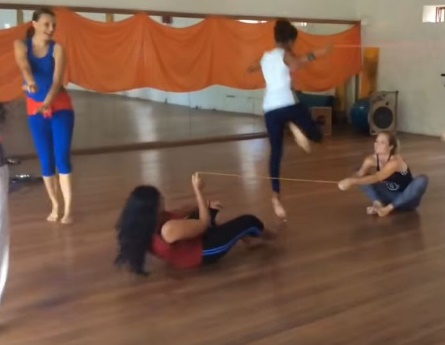
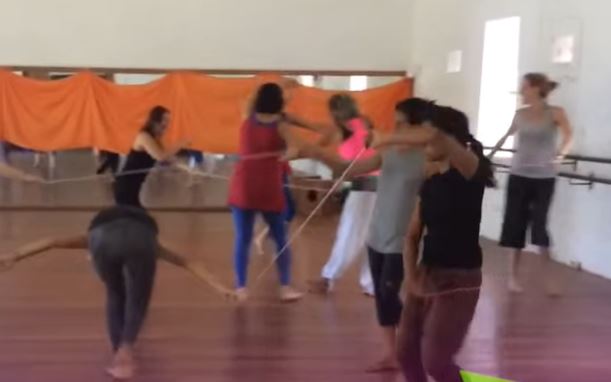
Source: https://www.youtube.com/watch?v=JOvcWFNzgdk
10. Release (Figure
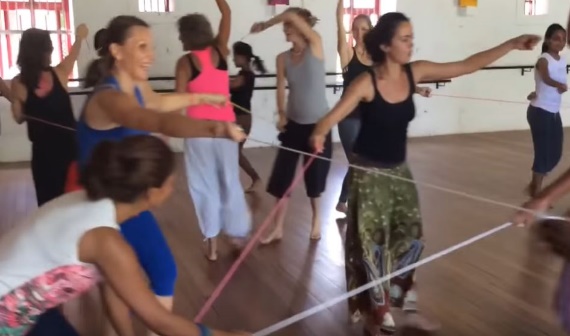
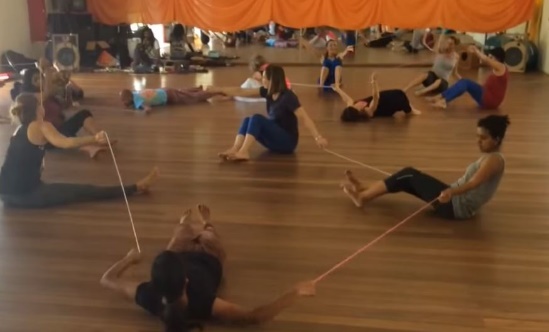
Source: https://www.youtube.com/watch?v=JOvcWFNzgdk
11. To be able all the participants to listen to each other, all the others (Figure
12. Confidence, self-confidence (Figure
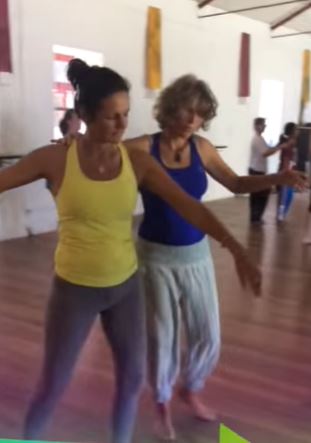
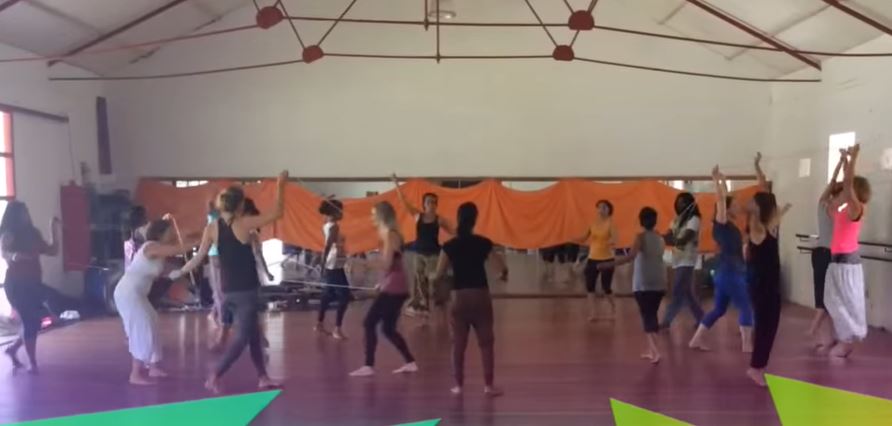
Source: https://www.youtube.com/watch?v=JOvcWFNzgdk
13. Let yourself, get caught! (Figure
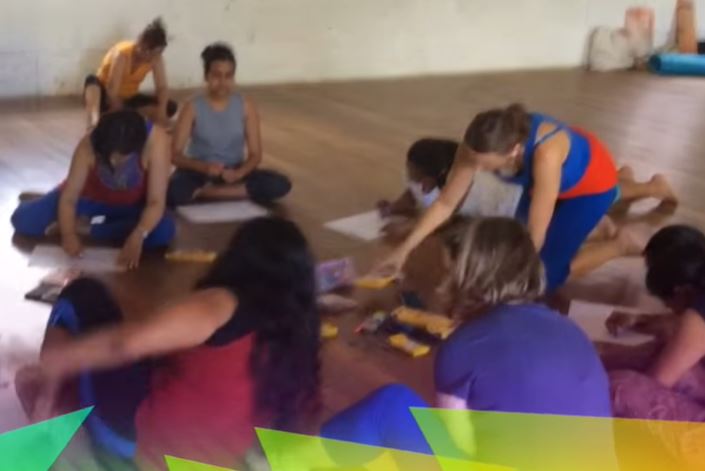
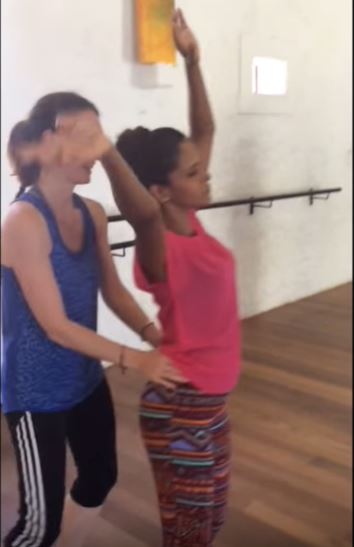
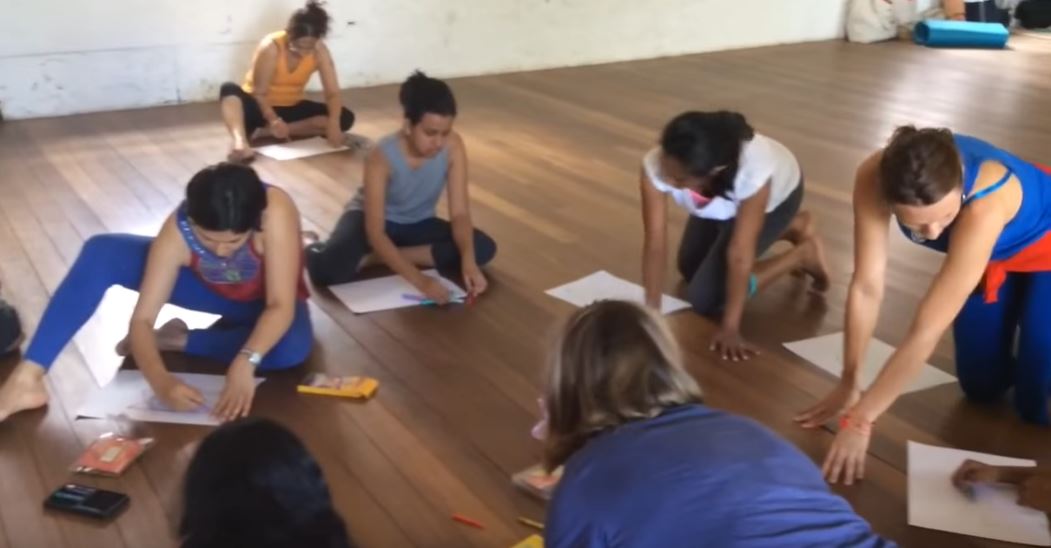
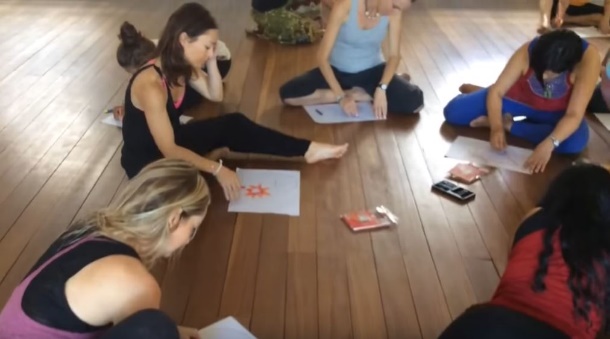
Source: https://www.youtube.com/watch?v=JOvcWFNzgdk
14. Express yourself and integrate! (Figure
Findings
Statistical indicators for AP2, MA, and AD tests.
Statistical processing was performed with the Excel application (from the Microsoft Office 2007 package), with the StatsDirect v.2.7.2 program. The graphical representation of the results was done with the Excel application (from the Microsoft Office 2007 package).
Test results and statistical analysis
T1 = initial test and T2 = final test
In the table
Comparing the results of the two measurements (from the beginning and the end of the intervention period) we managed to record in the tests used certain values that mean statistically significant changes between the two time points. These results, together with the statistical explanation, are presented in the tables and graphs below. At the end, the correlations between the indicators of the tests applied in the study will be presented.
In the statistical analysis of the values for the perception of attention and the spirit of observation (AP2) were observed statistically significant differences between the two times (p <0.001). The figures in Table
At the statistical analysis of the values for attention concentration (AD) no statistically significant differences were observed between the two times (p> 0.05).
At the statistical analysis of the values for distributive attention (AD) no statistically significant differences were observed between the two times (p> 0.05).
Statistically significant differences were observed in the indicators of the AP2 tests (perception of attention and observation) which indicates, as described above, that our intervention program in the preliminary study had a positive and measurable impact on students in terms of improving negative perceptions as well as increasing attention and observation
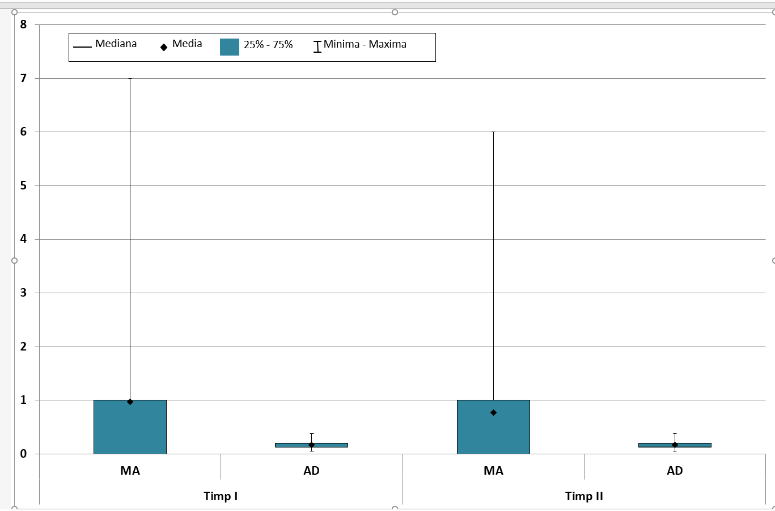
As Figure
Statistical correlation analysis for test values
at the initial testing (T1)
an acceptable but opposite correlation with AP2 - an interesting result that shows that the perception of attention and the spirit of observation diminishes. It is possible, however, that in the long run this correlation will be of the same meaning.
Statistical correlation analysis
at the initial testing (T1) - a weak / zero correlation with the AP2, MA, AD tests
at the final testing (T2) - an acceptable correlation and the same meaning as the AD test - As the level of relaxation increases, the level of distributive attention (AD) may also increase
- an acceptable correlation and the same meaning with the MA test - This result shows us a link between improving the perception of negative emotions such as "fear" or "sadness" and between increasing the concentration of attention (MA)
- a weak / zero correlation with the AP2 and AD tests.
Statistical correlation analysis for
On initial testing (T1)
an acceptable but opposite correlation with the AD test - We can deduce from this result that the perception of attention and the spirit of observation is directly correlated with the abilities of distributive attention
a weak / zero correlation with the MA test
On final testing (T2)
a good correlation but of the opposite direction with the MA test - The values show us that if the perception of attention and the spirit of observation will increase, the power of concentration will decrease.
a weak / zero correlation with the AD test
Statistical correlation analysis for MA test values showed a weak / zero correlation with the AD test at both times.
After apply our intervention program, we found a goor correlation between perception of attention (AP2) and concentration of attention (MA). First Testing (T1) had the value 0,0503 and after implementation of dance therapy programm become -0,6451. That means that perception of attention was increaseing, reults explain through a good correlation between two types of attention.
Conclusion
In order to meet the requirements of the Helsinki Declaration, Directive 86/609 / EEC and the regulations of the Ethics Commission of the institutions where the studies were carried out, we have previously obtained the informal agreement from the school, required in the research for studies on children and the agreement, respectively the collaboration of the sports teacher in the development without risks and impediments, of any nature, of the research. The research took place in a relaxing and trusting atmosphere.
No matter where we live in this world, we are all part of
After analyzing the postnatal quality of life of an experimental group of 30 women, the researchers concluded that the Jacobson technique is beneficial and should be recommended to women who are admitted to obstetrics and ambulatory clinics, and home visits should include this program (Gökşin & Ayaz-Alkaya, 2018).
Researchers in Japan have investigated changes in brain activity in association with progressive muscle relaxation, using functional magnetic resonance imaging. A change in brain activity has been observed in several areas, which means that the technique can suppress brain activity. Researchers suggest using the state of mental concentration even by novices (Kobayashi & Koitabashi, 2016). At the initial testing, an acceptable correlation was obtained, but in the opposite direction with the AD test - We can deduce from this result that the perception of attention and the spirit of observation is directly correlated with the abilities of distributive attention. In the final test, a good correlation was obtained, but in the opposite direction with the MA test - The values show that if the perception of attention and the spirit of observation increase, the power of attention concentration will decrease.
Statistically significant differences were observed in the indicators of the AP2 tests (perception of attention and observation) which indicates, as described above, that our intervention program in the preliminary study had a positive and measurable impact on students in terms of improving negative perceptions as well as increasing attention and observation.
The obtained results justify us to conclude that the advanced hypotheses in the preliminary research are validated, which gives us the opportunity to continue the research.
The results underline the importance of using psychological tests to detect the type of attention of each student in order to reduce its intensity and awareness of well-being. The obtained results confirm the hypothesis of the study. Following the results obtained, we conclude that students need a special intervention program created by us to determine the increase of attention items in order to improve the quality of life.
Acknowledgments
Thank you for the collaboration with Hanna Vari. This article is a small part of the her’s PhD.
References
- Allet, L., Müller-Pinget, S., Punt, I., Edelsten, C., Ballif, A., Golay, A., & Pataky, Z. (2017). Dance therapy combined with patient education improves quality of life of persons with obesity: A pilot feasibility study for a randomised controlled trial. Obesity research & clinical practice, 11(1), 79-87.
- Barksdale, A. (2006). Music Therapy and Leisure for Persons with Disabilities. Singamore Publishing.
- Bryman, A. (2009). Social Research Method. Oxford University Press
- Candela, M., Conte, R., Pastena, N., D’anna, C., & Gomez, F. (2013). The role of dancing in the Educational rocess. Procedia – Social and Behavioral Sciences, 106, 3069-3074.
- Dewhurst, S., Nelson, N., Dougall, P. K., & Bampouras, T. M. (2014). Scottish country dance: benefits to functional ability in older women. Journal of aging and physical activity, 22(1), 146-153.
- Giovagnoli, A. R., Oliveri, S., Schifano, L., & Raglio, A. (2014). Active music therapy improves cognition and behaviour in chronic vascular encephalopathy: A case report. Complementary therapies in medicine, 22(1), 57-62.
- Gökşin, I., & Ayaz-Alkaya, S. (2018). The effectiveness of progressive muscle relaxation on the postpartum quality of life: A randomized controlled trial. Asian nursing research, 12(2), 86-90.
- Hackett, S., Morison, C. J., & Pullen, C. (2013). A retrospective practice-based evaluation of music therapy: A single-case study of a four-year-old girl with Rett syndrome—Rebecca's story. The Arts in psychotherapy, 40(5), 473-477.
- Hanna, J. L. (1995). The power of dance: Health and healing. The Journal of Alternative and Complementary Medicine, 1(4), 323-331.
- Kassing, G. (2007). History of dance: an interactive arts approach. Human Kinetics.
- Kobayashi, S., & Koitabashi, K. (2016). Effects of preogressive muscle relaxation on cerebral activity: An fMRI investigation. Complementary Therapies in Medicine, 26, 33-39.
- Paul, S., & Ramsey, D. (2000). Music therapy in physical medicine and rehabilitation. Australian Occupational Therapy Journal, 47(3), 111-118.
- Rocha, P. A., Slade, S. C., McClelland, J., & Morris, M. E. (2017). Dance is more than therapy: Qualitative analysis on therapeutic dancing classes for Parkinson’s. Complementary therapies in medicine, 34, 1-9. https://doi.org/10.1016/j.ctim.2017.07.006
- Simavli, S., Kaygusuz, I., Gumus, I., Usluogulları, B., Yildirim, M., & Kafali, H. (2014). Effect of music therapy during vaginal delivery on postpartum pain relief and mental health. Journal of affective disorders, 156, 194-199. https://doi.org/10.1016/j.jad.2013.12.027
- [YouTube channel] https://www.youtube.com/watch?v=JOvcWFNzgdk, Retrived (2019, May 15)
- [YouTube channel] https://www.youtube.com/watch?v=l8K4cqI6OUk, Retrived (2018, October 18)
- [YouTube channel] https://www.youtube.com/watch?v=EyhjlVBLU5g Retrived (2019, November 21
Copyright information

This work is licensed under a Creative Commons Attribution-NonCommercial-NoDerivatives 4.0 International License.
About this article
Publication Date
31 March 2021
Article Doi
eBook ISBN
978-1-80296-103-4
Publisher
European Publisher
Volume
104
Print ISBN (optional)
-
Edition Number
1st Edition
Pages
1-536
Subjects
Education, teacher, digital education, teacher education, childhood education, COVID-19, pandemic
Cite this article as:
Florina, G. E., Imola, V. H., Teodor, G. V., Adrian, R. R., & Adrian, M. A. (2021). Usıng Dance -Therapy Programs To Develop Attentıon In 13-14 Aged Old Student. In I. Albulescu, & N. Stan (Eds.), Education, Reflection, Development – ERD 2020, vol 104. European Proceedings of Social and Behavioural Sciences (pp. 218-227). European Publisher. https://doi.org/10.15405/epsbs.2021.03.02.24

